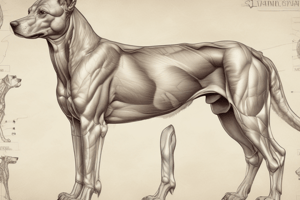Podcast
Questions and Answers
What is the first step in CPR management?
What is the first step in CPR management?
- Administering drugs
- Monitoring chest rise and deflation
- Performing external cardiac compressions
- Checking for airway obstruction (correct)
What is the recommended rate for external cardiac compressions?
What is the recommended rate for external cardiac compressions?
- 100-120 compressions per minute (correct)
- 130-140 compressions per minute
- 50-60 compressions per minute
- 70-80 compressions per minute
Which drug is used in CPR to determine arrest rhythm?
Which drug is used in CPR to determine arrest rhythm?
- Adrenaline (correct)
- Lidocaine
- Vasopressin
- Atropine
What is the purpose of using 100% O2 in CPR?
What is the purpose of using 100% O2 in CPR?
What technique is preferred for small dogs, cats, and large, barrel-chested breeds during external cardiac compressions?
What technique is preferred for small dogs, cats, and large, barrel-chested breeds during external cardiac compressions?
What is the main purpose of compression techniques in CPR?
What is the main purpose of compression techniques in CPR?
What is the preferred rate for successful external compressions?
What is the preferred rate for successful external compressions?
In which conditions are internal cardiac compressions preferred?
In which conditions are internal cardiac compressions preferred?
What is the purpose of ECG monitoring in CPR?
What is the purpose of ECG monitoring in CPR?
What is discussed in relation to drug administration routes in CPR?
What is discussed in relation to drug administration routes in CPR?
What are the key components of breathing in CPR?
What are the key components of breathing in CPR?
What is essential to determine arrest rhythm in CPR?
What is essential to determine arrest rhythm in CPR?
What is the main purpose of cardiopulmonary resuscitation (CPR)?
What is the main purpose of cardiopulmonary resuscitation (CPR)?
What are the signs of cardiopulmonary arrest (CPA)?
What are the signs of cardiopulmonary arrest (CPA)?
What is a possible cause of cardiopulmonary arrest related to pH extremes?
What is a possible cause of cardiopulmonary arrest related to pH extremes?
What is the significance of blood appearance in diagnosing cardiopulmonary arrest?
What is the significance of blood appearance in diagnosing cardiopulmonary arrest?
Which condition is not a possible cause of cardiopulmonary arrest?
Which condition is not a possible cause of cardiopulmonary arrest?
What is the role of mucous membrane color in diagnosing cardiopulmonary arrest?
What is the role of mucous membrane color in diagnosing cardiopulmonary arrest?
Which action is part of basic cardiac life support in CPR?
Which action is part of basic cardiac life support in CPR?
What is the primary cause of myocardial hypoxia leading to cardiopulmonary arrest?
What is the primary cause of myocardial hypoxia leading to cardiopulmonary arrest?
In CPR, what does prolonged CRT indicate?
In CPR, what does prolonged CRT indicate?
What is the significance of eye central with a dilated pupil in diagnosing cardiopulmonary arrest?
What is the significance of eye central with a dilated pupil in diagnosing cardiopulmonary arrest?
What is the primary action to be taken in advanced cardiac life support during CPR?
What is the primary action to be taken in advanced cardiac life support during CPR?
What is the primary goal of ECG monitoring in CPR?
What is the primary goal of ECG monitoring in CPR?
What is the recommended rate for external cardiac compressions?
What is the recommended rate for external cardiac compressions?
What is the main purpose of compression techniques in CPR?
What is the main purpose of compression techniques in CPR?
What is essential to determine arrest rhythm in CPR?
What is essential to determine arrest rhythm in CPR?
What is the purpose of using 100% O2 in CPR?
What is the purpose of using 100% O2 in CPR?
What is discussed in relation to drug administration routes in CPR?
What is discussed in relation to drug administration routes in CPR?
What technique is preferred for small dogs, cats, and large, barrel-chested breeds during external cardiac compressions?
What technique is preferred for small dogs, cats, and large, barrel-chested breeds during external cardiac compressions?
What is the purpose of A-B-C (Airway, Breathing, Circulation) in CPR management?
What is the purpose of A-B-C (Airway, Breathing, Circulation) in CPR management?
What is the first step in CPR management?
What is the first step in CPR management?
What is the purpose of ECG monitoring in CPR?
What is the purpose of ECG monitoring in CPR?
What is the purpose of rapid clip, incision, and ventilation in internal cardiac compressions?
What is the purpose of rapid clip, incision, and ventilation in internal cardiac compressions?
What is the purpose of drug administration routes in CPR?
What is the purpose of drug administration routes in CPR?
What is the purpose of monitoring chest rise and deflation in CPR?
What is the purpose of monitoring chest rise and deflation in CPR?
Flashcards are hidden until you start studying
Study Notes
Canine Cardiopulmonary Resuscitation: Key Points
- CPR management involves time sensitivity, A-B-C (Airway, Breathing, Circulation), drugs, electrical defibrillation, and follow-up.
- Airway management includes checking for obstruction and using endotracheal intubation or narrow catheter if necessary.
- Breathing involves IPPV, 100% O2, 10 breaths per minute, and monitoring chest rise and deflation.
- Circulation management includes checking pulses/heart sounds, continuous monitoring, and maintaining compressions.
- External cardiac compressions techniques vary for small dogs, cats, and large, barrel-chested breeds.
- Compression techniques produce output through indirect compression of the heart and increasing intrathoracic pressure.
- Successful external compressions require a rate of 100-120/min, proper table position, and allowing adequate time for recoil.
- Internal cardiac compressions are preferred in certain conditions and involve rapid clip, incision, and ventilation.
- Drug administration routes, such as central/jugular injection, peripheral injection, intraosseous, and transtracheal, are discussed.
- Drugs used in CPR include adrenaline, atropine, lidocaine, and vasopressin, with specific doses and indications.
- ECG monitoring is essential to determine arrest rhythm, which can be asystole, ventricular fibrillation, or pulseless electrical activity.
- Survival after CPR is reported, and the actions during an arrest, equipment needed, and signs of effective CPR and recovery are detailed.
Canine Cardiopulmonary Resuscitation: Key Points
- CPR management involves time sensitivity, A-B-C (Airway, Breathing, Circulation), drugs, electrical defibrillation, and follow-up.
- Airway management includes checking for obstruction and using endotracheal intubation or narrow catheter if necessary.
- Breathing involves IPPV, 100% O2, 10 breaths per minute, and monitoring chest rise and deflation.
- Circulation management includes checking pulses/heart sounds, continuous monitoring, and maintaining compressions.
- External cardiac compressions techniques vary for small dogs, cats, and large, barrel-chested breeds.
- Compression techniques produce output through indirect compression of the heart and increasing intrathoracic pressure.
- Successful external compressions require a rate of 100-120/min, proper table position, and allowing adequate time for recoil.
- Internal cardiac compressions are preferred in certain conditions and involve rapid clip, incision, and ventilation.
- Drug administration routes, such as central/jugular injection, peripheral injection, intraosseous, and transtracheal, are discussed.
- Drugs used in CPR include adrenaline, atropine, lidocaine, and vasopressin, with specific doses and indications.
- ECG monitoring is essential to determine arrest rhythm, which can be asystole, ventricular fibrillation, or pulseless electrical activity.
- Survival after CPR is reported, and the actions during an arrest, equipment needed, and signs of effective CPR and recovery are detailed.
Studying That Suits You
Use AI to generate personalized quizzes and flashcards to suit your learning preferences.




